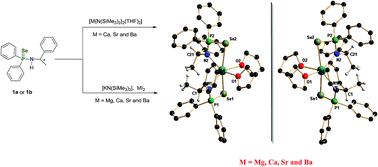Chiral alkaline earth metal complexes with M–Se direct bond (M = Mg, Ca, Sr, Ba): syntheses, structures and ε-caprolactone polymerisation†
Abstract
We report here a series of enantiomeric pure alkaline earth metal complexes, each with a metallic direct bond of selenium, with {HN(R-*CHMePh)(P(Se)Ph2)} (1a) and {HN(S-*CHMePh)(P(Se)Ph2)} (1b), synthesised using two routes. The first route involves a trans metalation reaction of enantiomeric pure potassium phosphinoselenoic amide [K{N(R-*CHMePh)(Ph2P(Se))}{THF}n] (2a) or [K{N(S-*CHMePh)(Ph2P(Se))}{THF}n] (2b) prepared from the reaction between either 1a or 1b and [KN(SiMe3)2], and the corresponding alkaline earth metal diiodies in THF at room temperature to afford the enantiomeric pure complexes of composition [M{N(R-*CHMePh)P(Se)Ph2}2(THF)n] [M = Mg (3a), n = 1; M = Ca (4a), Sr (5a) and Ba (6a), n = 2] and [M{N(S-*CHMePh)P(Se)Ph2}2(THF)n] [M = Mg (3b), n = 1; M = Ca (4b), Sr (5b) and Ba (6b), n = 2]. The same heavier alkaline earth metal complexes (4a–6a and 4b–6b) can also be obtained through the silylamine elimination method using the corresponding metal bis(trimethylsilyl)amides [M{N(SiMe3)2}2(THF)n] (M = Ca, Sr, Ba) with phosphinoselenoic amine ligands 1a and 1b in ambient conditions. The solid-state structures of the metal complexes 4a–6a and 4b–6b were established using single-crystal X-ray diffraction analysis. In the solid state, all the metal complexes crystallise in the monoclinic P21 space group and each phosphinoselenoic amido ligand is ligated to the metal ion in a bidentate fashion. We also report the syntheses and structures of chiral amidophosphine-borane ligands {HN(R-*CHMePh)(P(BH3)Ph2)} (7a) and {HN(S-*CHMePh)(P(BH3)Ph2)} (7b) and the corresponding homoleptic barium complexes of composition [Ba{N(R-*CHMePh)P(BH3)Ph2}2(THF)2] (8a) and [Ba{N(R-*CHMePh)P(BH3)Ph2}2(THF)2] (8b). The molecular structures of 8a and 8b in the solid state confirm the attachment of chiral amidophosphine-borane ligands to the barium ions. The complexes 5 and 6 were tested as catalysts for the ring-opening polymerisation of ε-caprolactone. High activity in relation to the barium complexes 6a and 6b is observed, with moderate to narrow polydispersity index.


 Please wait while we load your content...
Please wait while we load your content...